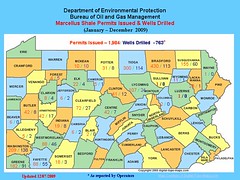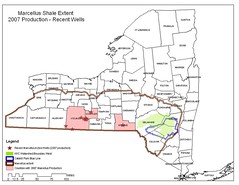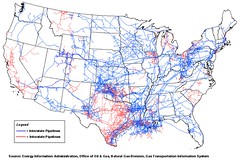The New York Times
Bowing to intense public pressure, the Chesapeake Energy Corporation says it will not drill for natural gas within the upstate New York watershed, an environmentally sensitive region that supplies unfiltered water to nine million people.
The reversal seems to signal a more conciliatory tone from the gas industry, which is facing mounting opposition in New York to its drilling practices. The decision also increases the pressure on state regulators to reverse their decision to allow drilling within the watershed.
“We are not going to develop those leases, and we are not taking any more leases, and I don’t think anybody else in the industry would dare to acquire leases in the New York City watershed,” Aubrey K. McClendon, the chief executive officer at Chesapeake Energy, said in an interview on Monday in Fort Worth. “Why go through the brain damage of that, when we have so many other opportunities?”
...
Chesapeake, one of the nation’s biggest gas producers, is the largest leaseholder in the Marcellus Shale, a subterranean layer of shale rock that runs from New York to Tennessee.
...
But the concerns include the use of chemicals, the disposal of wastewater and the danger of leaks and spills into groundwater and deep aquifers. There also has been a string of explosions from Wyoming to Pennsylvania.
...
Chesapeake acquired 5,000 acres in the watershed when it bought Columbia Natural Resources a few years ago, and it is currently the only leaseholder in the area.
Over all, Mr. McClendon said, the company’s holdings in the watershed are “a drop in the bucket” compared with the Marcellus field’s potential. He suggested that Chesapeake had more to lose by drilling there than by forgoing it, even though he contended such drilling would do no harm.
“How could any one well be so profitable that it would be worth damaging the New York City water system?” he said.
State officials have been eager to embrace the drilling because of its potential economic benefits, especially in the current downturn. This month, the state’s environmental agency said it would allow companies to drill throughout the state, imposing few specific limits on operations.
The proposed regulations, which were requested last year by Gov. David A. Paterson, do not ban drilling in the watershed, as many New York City officials and environmental advocates had urged, but would require buffer zones around reservoirs and aqueducts.
Gas industry representatives say the rules, if enacted, will be among the most restrictive in the country. Opponents say they would be inadequate to prevent contamination.
The New York watershed is an area of about one million acres, representing 4 percent of the state’s total surface. Thanks to gravity, water from the region’s rivers and streams flows to six reservoirs in the Catskills, and then, through a series of aqueducts and tunnels, to the taps of New Yorkers. This system provides unfiltered drinking water for half the state’s population, including 8.2 million people in New York City and about one million people in Westchester, Putnam and Dutchess Counties.
Some New York City politicians welcomed Chesapeake’s decision and said they hoped it would have a broader impact. “To proceed with drilling doesn’t make any business sense and doesn’t make environmental sense, and I think Chesapeake understands this, and I am happy they have come to that decision,” said James F. Gennaro, chairman of the City Council’s Committee on Environmental Protection. “If only we could get the state government to come to the same realization. It is strangely ironic.”
Chesapeake’s announcement was also praised by environmental advocates as a positive step. They said the company’s position should encourage the state to reverse its decision and impose an outright drilling ban throughout the watershed.
“When the industry says it will not drill in the watershed, it sends a strong message to state regulators that drilling there is inappropriate,” said James L. Simpson, an attorney at Riverkeeper, an environmental group.
Hydraulic fracturing pumps huge volumes of water laced with chemicals like benzene into the shale to break it and release the natural gas. The process has been linked to contamination of water wells and the death of livestock exposed to potassium chloride, a chemical used during drilling.
State environmental regulators have said they saw no “realistic threat” to water quality that would warrant a drilling ban in the two watersheds in the Catskills region. Their environmental review noted that the city controlled a large amount of the land surrounding the reservoirs and could deny permission to drill in those areas.
In addition to the forum on Wednesday, hearings on the state’s proposed regulations are scheduled Nov. 10 in New York City, Nov. 12 in Broome County and Nov. 18 in Steuben County.
Chesapeake said it had started to publicize the chemical components of the fluids it uses during drilling, down to the percentages for each chemical used since last year, acknowledging criticism that companies had not been transparent enough. “The industry is moving quickly to complete disclosure," Mr. McClendon said.For the complete report, CLICK HERE.
Mireya Navarro contributed reporting.



















No comments:
Post a Comment